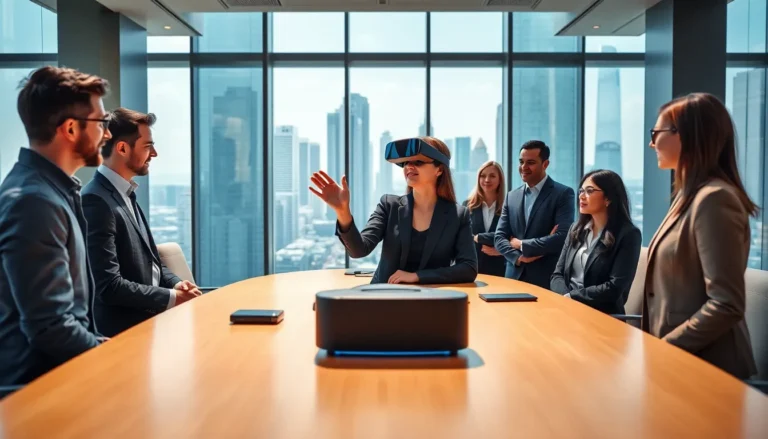Ever found yourself squinting at a prescription label trying to decipher what your doctor wrote? Enter augmented reality (AR) in pharmacy, the technology that promises to turn confusion into clarity. Imagine donning a pair of smart glasses and instantly seeing vital information about your medication pop up right before your eyes. With a blend of humor and innovation, this article dives into how augmented reality is revolutionizing the pharmacy landscape, making it smarter, safer, and a lot more user-friendly. Get ready to explore the future of healthcare, where the mundane meets the magical.
Table of Contents
ToggleWhat Is Augmented Reality in Pharmacy?

Augmented reality in pharmacy combines the real world with digital information, allowing patients and healthcare professionals to interact with medical data in a visually engaging way. Essentially, AR overlays a digital layer onto the real world through devices like smartphones, tablets, or smart glasses. For pharmacy, this means bringing crucial medication details directly into the user’s field of vision.
By simply pointing a device at a prescription label or a medicine bottle, patients gain instant access to guidance about dosages, side effects, and drug interactions. It turns complicated pharmaceutical jargon into straightforward information that just about anyone can understand. So, if you’ve ever struggled with medical terms that read like they’re in a foreign language, AR is the breakthrough you didn’t know you needed.
This technology isn’t limited to patients, though. Pharmacists also benefit from augmented reality, using AR for enhanced training and ensuring they’re up-to-date with the latest medications and treatment guidelines.
Benefits of Augmented Reality in Pharmacy
The introduction of augmented reality in pharmacy offers a plethora of benefits that enhance both patient experience and pharmaceutical practices.
- Improved Understanding: With visual aids accompanying written information, patients can better grasp what they are taking. It transforms learning into a more engaging experience.
- Minimized Errors: By providing real-time information, AR can help prevent medication errors that might occur from interpreting prescriptions wrongly. No more guessing what the doctor meant when they wrote ‘take twice daily’.
- Enhanced Education and Training: Pharmacists can use AR to learn about new medications and their effects without the usual tedious textbook methods. It offers simulation-like training that can bring scenarios to life.
- Increased Patient Engagement: The interactive nature of augmented reality tends to engage patients, making them more involved in their health management. They can ask questions, or even better, see answers pop up in 3D.
- Efficiency Boost: Pharmacists can process prescriptions faster with augmented reality aids that streamline workflows. This leads to reduced waiting times for patients and more efficient service overall.
With benefits like these, it’s clear that AR isn’t just a gimmick: it’s paving the way for a more informed and safer healthcare experience.
Applications of Augmented Reality in Pharmacy
Augmented reality in pharmacy finds various applications that keep extending its reach. Here are some exciting ways this technology is being leveraged:
- Medication Visualization: Patients can use their smartphones to visualize how their medications work. By scanning their prescription bottles, they can watch animations showing how the drug interacts with their body. It’s like watching a mini-movie about one’s health.
- Interactive Labels: Imagine scanning a label and instantly receiving detailed information about the medication. This can include how to take it, potential side effects, and even video tutorials for additional guidance.
- Pharmacist Training Simulations: Future pharmacists can benefit greatly from AR by simulating realistic pharmacy environments. They can practice scenarios from consulting with patients to managing inventory without the consequences of making a mistake in the real world.
- Personalized Health Insights: AR can provide a tailored experience, showing patients not just what their medication is but how it specifically affects their health conditions.
- Remote Consultations: During telehealth sessions, pharmacists can use AR to show patients visual representations of their medications, enhancing comprehension during online consultations, especially for those who might be more visual learners.
As AR technology evolves, its applications in pharmacy will undoubtedly expand, transforming how patients and pharmacists interact.
Challenges and Limitations of Augmented Reality in Pharmacy
Even though its many advantages, implementing augmented reality in pharmacy is not without challenges and limitations.
- Cost: Developing and deploying AR technology can be expensive. Pharmacies may hesitate to invest heavily in technology without guaranteed returns.
- Technology Adoption: Not all pharmacists or patients are tech-savvy. A learning curve exists, and some individuals may find AR applications intimidating rather than helpful.
- Data Privacy Concerns: With the integration of digital information comes the need for stringent data privacy measures. Ensuring that patient data remains secure while using AR platforms is paramount.
- Integration with Existing Systems: Incorporating AR into current pharmacy management systems can create compatibility issues. Effective solutions must not disrupt existing workflows while enhancing them.
- Limited Content: The effectiveness of AR in pharmacy depends on the quality and availability of content. If the information is outdated or inaccurate, it can compromise patient safety.
These challenges highlight that while the pathway to augmented reality pharmacy is paved with potential, careful navigation is necessary to maximize benefits and minimize risks.
Future Trends in Augmented Reality Pharmacy
As augmented reality continues to develop, several exciting trends are shaping the future of pharmacy.
- Broader Implementation: Expect to see AR becoming standard in pharmacies across both retail and clinical settings. With advancing hardware and software, AR systems will likely become more accessible.
- AI Integration: Combining artificial intelligence with AR could create even more sophisticated applications. Imagine an AR system that learns a patient’s history and tailors information based on their previous interactions.
- Wearable Technology: Smart glasses and other wearables could become commonplace for both patients and pharmacists. This would free up hands for tasks while still providing crucial visual information.
- Telepharmacy Services: The rise of telehealth will likely lead to the adaptation of AR in remote pharmacy consultations. Pharmacists may be able to explain drug interactions in real time across a video call while showing visual representations.
- Enhanced Safety Regulations: Expect stricter guidelines around AR applications in healthcare, ensuring patient safety is always a priority.
As these trends unfold, the augmented reality pharmacy landscape promises to become an integral part of the medical field, enriching the experiences of pharmacists and patients alike.






